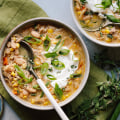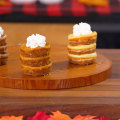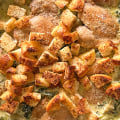Ingredients
- 7 to 8 pounds boneless country-style ribs, trimmed of most but not all excess fat
- 3 tablespoon achiote oil (below)
- 2 tablespoon vinegar
- 2 tablespoon olive oil
- 6 cup manchamanteles (recipe follows)
- 7 to 8 pounds boneless country-style ribs, trimmed of most but not all excess fat
- 3 tablespoon achiote oil (below)
- 2 tablespoon vinegar
- 2 tablespoon olive oil
- 6 cup manchamanteles (recipe follows)
- 2 ripe medium plum tomatoes (about 8 ounces)
- 3 tablespoon olive oil
- 1 tablespoon large white onion (about 1 1/4 pounds), halved then cut into thin slices (about 4 cups)
- 1 teaspoon dried oregano
- 1/2 teaspoon ground cumin
- 1/2 cup ancho chile paste (see note)
- 6 cup homemade or store-bought chicken broth, or as needed
- 1 cup (20-ounce) can crushed pineapple, with juice
- 1 cup mango, peeled, pitted and cut into 1/4-inch dice (about 1 1/2 cups)
- 4 ounce dried apricots, cut into 1/4-inch dice (about 2/3 cup)
- 1 teaspoon ground cinnamon
- 1/4 teaspoon ground clove
- 1/4 teaspoon ground allspice
- 1/4 teaspoon ground ginger
- 1/4 teaspoon freshly ground pepper
- 7 to 8 pounds boneless country-style ribs, trimmed of most but not all excess fat
- 3 tablespoon achiote oil (below)
- 2 tablespoon vinegar
- 2 tablespoon olive oil
- 6 cup manchamanteles (recipe follows)
- 2 ripe medium plum tomatoes (about 8 ounces)
- 3 tablespoon olive oil
- 1 tablespoon large white onion (about 1 1/4 pounds), halved then cut into thin slices (about 4 cups)
- 1 teaspoon dried oregano
- 1/2 teaspoon ground cumin
- 1/2 cup ancho chile paste (see note)
- 6 cup homemade or store-bought chicken broth, or as needed
- 1 cup (20-ounce) can crushed pineapple, with juice
- 1 cup mango, peeled, pitted and cut into 1/4-inch dice (about 1 1/2 cups)
- 4 ounce dried apricots, cut into 1/4-inch dice (about 2/3 cup)
- 1 teaspoon ground cinnamon
- 1/4 teaspoon ground clove
- 1/4 teaspoon ground allspice
- 1/4 teaspoon ground ginger
- 1/4 teaspoon freshly ground pepper
- 1 cup olive oil
- 2 tablespoon achiote (annatto) seeds
Preparation
Baking Directions:
To make the pork ribs:Cut the spareribs into single serving size pieces if necessary.
Pat the ribs dry with paper towels and put them in a large bowl.
Rub the achiote oil into all sides of the ribs with your hands, then sprinkle the vinegar over them and toss to mix.
Season liberally with adobo, rubbing the seasoning into the pork and making sure all sides of the ribs are well seasoned.
Let them stand at room temperature for an hour or cover and refrigerate for up to 2 days.
(Hint: 2 days is better!)Preheat the oven to 400 degrees F.
Heat the olive oil in a wide heavy skillet over medium-high heat.
Add as many of the seasoned ribs as fit without touching.
Brown them well on all sides, about 15 minutes total.
Remove them to an 11 x 15-inch baking dish (or other dish in which they fit snugly in a single layer) and repeat with the remaining ribs.
Spoon the manchamanteles over the ribs, wiggling the dish so the sauce works its way between the ribs.
Cover the dish with a sheet of parchment paper and then a sheet of foil, crimping the foil to the sides of the dish to make a tight seal.
Bake until the ribs are fork tender, about 1 3/4 hours.
Remove and cool to room temperature.
Refrigerate 1 to 2 days.
You could serve the ribs right away, but they will be noticeably better-the flavor will have permeated every inch of the ribs-after a couple of days.
Also, the fat will rise to the top, making it easy to remove before reheating.
To serve:Bring the ribs to room temperature.
Meanwhile, preheat the oven to 350 degrees F.
Spoon/scrape the fat from the top of the sauce and ribs.
Bake the ribs, uncovered, 20 minutes.
Remove the baking dish from the oven and, very carefully, turn the ribs over in the sauce.
Return to the oven until heated through, 20 to 25 minutes.
(It's unlikely, but if the ribs appear even slightly dry, cover the dish after turning the ribs.)
Spoon a little of the pan sauce over the ribs and serve them from the baking dish right away.
To make the manchamanteles (chile-fruit mole):This recipe makes about 7 cups.
This type of mole, manchamanteles, (or "tablecloth-stainer"), is so named for the vibrant color contributed by chiles and fruit — and the mess that people make digging into the finished dish! Core the tomatoes and cut them in half lengthwise.
Heat a small, heavy skillet (preferably cast-iron) over medium-high heat until very hot.
Add the tomatoes skin-side down and cook, turning once, until charred on most of both sides, about 8 minutes.
Set them aside.
Heat the oil in a large deep skillet over medium-high heat.
Add the onions and cook, stirring often, until they just begin to take on some color, about 8 minutes.
Add the oregano and continue cooking until the onions are lightly browned, about 3 minutes.
Stir in the cumin, then the ancho paste.
Keep stirring and cooking until the onions are coated with the chile paste.
Stir in 6 cups broth and heat to boiling, then slip in the charred tomatoes.
Adjust the heat so the sauce is simmering and cook until the onions are very tender, about 20 minutes.
Working in batches, blend the sauce base until smooth.
To avoid splattering, either cool the sauce to tepid or work in very small batches and/or use a folded-up kitchen towel to clamp the lid to the blender while it's running.
Rinse out the pot.
Return the sauce base to the pot.
Stir in the pineapple with its juice, the mango, apricot, cinnamon, cloves, allspice, ginger and black pepper.
Season lightly with salt and bring to a boil, then adjust the heat so the sauce is simmering.
Cook until the sauce is slightly thickened and takes on a nice shine, about 20 minutes.
The sauce may be prepared up to 3 days in advance and refrigerated.
Note: Ancho chile paste is traditionally made by toasting dried ancho chiles until softened, seeding them and pureeing the chile until very smooth.
After pureeing, the paste is pushed through a fine sieve to remove all traces of skin and any stray seeds.
The new tradition in my kitchen is to order ancho paste online.
An excellent ancho paste (and pastes made from other chiles) is available online from Purcell Mountain Farms.
Alternatively, substitute dried ancho chiles for the paste: Lightly toast 6 to 8 dried ancho chiles in a heavy skillet over medium-low heat just until they change color and smell wonderful, about 1 minute per side.
Pull out the stems and tap out the seeds.
Put the toasted chiles in a large bowl and pour in enough hot water to cover them.
Weight them with a plate to keep them submerged and soak them until softened, about 20 minutes.
Drain them thoroughly, tear them into large pieces, and put them in a blender jar.
Blend, adding just enough fresh water to make a very coarse puree.
Any seeds and skins you may have missed will be strained out of the sauce before adding the fruit.
To make the achiote oil:Many countries in Latin America color and flavor their food with saffron.
My preference for an equally beautiful color, subtler flavor, and less expensive alternative is achiote oil.
Heat the oil and annatto seeds in a small skillet over medium heat just until the seeds give off a lively, steady sizzle.
Don't overheat the mixture or the seeds and oil will both end up discolored and unusable.
Once the really get sizzling, remove the pan from the heat and let it stand until the sizzling stops.
Strain the oil and discard the seeds.
Store the oil for up to 4 days at room temperature in a jar with a tight-fitting lid.
Makes about 1 cup.




